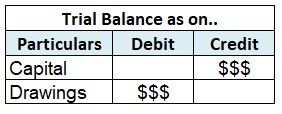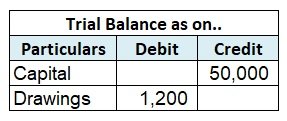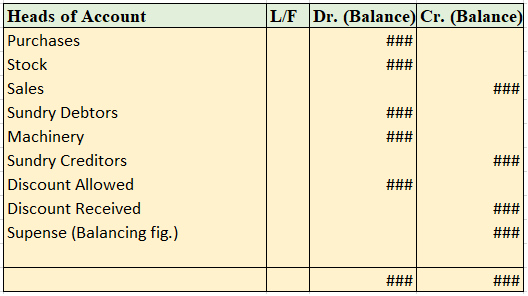Drawings mean the certain sum of amount or goods withdrawn by owners from the business for personal use. The drawings account is not an asset/liability/expense/income account, it is a contra account to the owner's equity or capital account. Drawings A/c will always have a debit balance. Drawings A/cRead more
Drawings mean the certain sum of amount or goods withdrawn by owners from the business for personal use. The drawings account is not an asset/liability/expense/income account, it is a contra account to the owner’s equity or capital account. Drawings A/c will always have a debit balance.
Drawings A/c debit balance is contrary to the Capital A/c credit balance because any withdrawal from the business for personal use will reduce the capital.
Effect on Trial Balance: Drawings will be shown in the debit column of the trial balance.

Effect on Financial Statements: The owner’s drawings will affect the company’s balance sheet by decreasing the asset that is withdrawn, and a corresponding decrease in the owner’s equity or capital invested.

Example:
Mr.B a sole proprietor withdraws $100 each month for personal use. At the end of the year Drawings A/c had a debit balance of $1,200.
Mr.B records drawings of $100 each month and debits drawings a/c and credits cash a/c. At the end of the year, he will transfer the balance and will debit capital a/c and credit drawings a/c by $1,200.
He will show a balance of $1,200 ($100*12) in the trial balance in the debit column. Assuming closing capital of $50,000.

In the financial statement, the balance of drawings a/c will be deducted from the owner’s capital because it is a contra account and this will reduce the owner’s capital for the year.

See less












 The trial balance shows the opening balance of various accounts. Now posting them in ledger accounts.
The trial balance shows the opening balance of various accounts. Now posting them in ledger accounts.



















20 Journal Entries Journal is the book of initial entry, hence the transactions are at first recorded in the journal by the way of journal entries. Journal entries are made as per the double entry system of accounting, where for each transaction one account is debited and another account is creditedRead more
20 Journal Entries
Journal is the book of initial entry, hence the transactions are at first recorded in the journal by the way of journal entries.
Journal entries are made as per the double entry system of accounting, where for each transaction one account is debited and another account is credited.
In the case of compound journal entries, one set of accounts is debited and one set of accounts is credited.
The amount of debit and credit always remains the same.
For example, when cash is introduced into a business, it affects two accounts: Cash A/c and Capital A/c. The accounts are debited and. credited as per the golden rules of accounting.
The journal entries which I have provided are based on the following transactions and events:
Journal Entries
The journal entries based on the above are as follows:
Ledgers
Ledger is known as the book of final entry. It is the book where the transactions related to a specific account are posted. This posting of transactions is done from journal entries.
The posting of journal entries into the ledger is performed in the following way:
The journal entry of cash sales is :
Here, Cash A/c is debited to Sales A/c. So, in the Cash A/c ledger, posting will be made on the debit side as “To Sales A/c”
In the Sales A/c ledger, the posting will be made on the credit as “By Cash A/c” because Sales A/c is credited to Cash A/c
For creating ledgers, journal entries are a prerequisite.
Now, the ledgers to be created as per the journal entries made above are as follows:
The account ledgers are as follows:
Trial Balance
A trial balance is a statement that is prepared to check the arithmetical accuracy of books of accounts.
In this statement, the total of all accounts having debit balance and the total of all accounts having credit balance is computed. If the total of debit and credit matches, then it can be said that the books of accounts are arithmetically accurate.
Here also we have prepared the trial balance by computing the total of accounts having debit balances and the total of accounts having credit balances
The debit column total and credit column total are matching. Hence, we can say that the books of accounts we have prepared are arithmetically accurate.
Note: Matt A/c and Uday A/c have not appeared in the trial balance because they do not have any carrying balance.
See less